

Untitled. A new report, supported by Adobe, aims to establish a shared vision of digital literacy and serve as a call to action for higher education leaders across the United States.
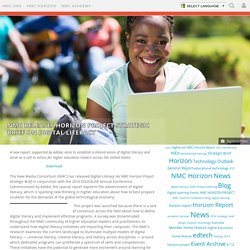
The New Media Consortium (NMC) has released Digital Literacy: An NMC Horizon Project Strategic Brief in conjunction with the 2016 EDUCAUSE Annual Conference. Commissioned by Adobe, the special report explores the advancement of digital literacy, which is sparking new thinking in higher education about how to best prepare students for the demands of the global technological economy. This project was launched because there is a lack of consensus across the field about how to define digital literacy and implement effective programs.
A survey was disseminated throughout the NMC community of higher education leaders and practitioners to understand how digital literacy initiatives are impacting their campuses. > Download the report (PDF) On Digital Literacies – ProfHacker - Blogs - The Chronicle of Higher Education. This post is co-authored with fellow Prof Hacker Lee Skallerup Bessette and Autumm Caines, Associate Director of Academic Technology in the Center for Excellence in Learning and Teaching at Capital University in Columbus Ohio, and co-director of Virtually Connecting.
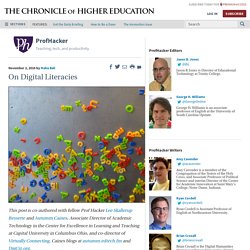
Caines blogs at autumm.edtech.fm and DigCiz.org. “Buying into a system doesn’t automagically make you, or a University, digitally literate or creative” — Sheila MacNeill The New Media Consortium recently released a Strategic Brief on Digital Literacy. This post is co-authored as a preliminary response to this report: Lack of description of the variety in the field. Digital Skills Framework. The Open Textbook Project provides flexible and affordable access to higher education resources. Crap Detection Mini-Course. How to Create a Robust and Meaningful Personal Learning Network [PLN] Home - e-Volution Technology Forum. Teaching Online? Keep These Best Practices in Mind · BrigitteCScott. 9 Tips To Apply Adult Learning Theory to eLearning. In this article I'll discuss how Knowles' 5 adult learning theory assumptions can be translated to modern day eLearning experiences, so that you can integrate the 4 principles of Andragogy into your eLearning course for maximum learner engagement and motivation.
According to the renowned American educator, Malcolm Knowles there are 5 assumptions concerning the characteristics of adult learners, and 4 principles concerning adult learning (andragogy). Micro-Learning: Its Role in Formal, Informal and Incidental Learning. Saving Twitter Chat Archives. My last four blog posts have been about Twitter Chats, which are real-time, online conversations that use specific hashtags to help organize the discussion.
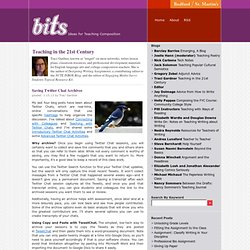
I’ve talked about Connecting with Colleagues and Teaching with Twitter Chats, and I’ve shared some Introductory Twitter Chat Activities and some Advanced Twitter Chat Activities. Why archive? 51 Twitter Chat & Hashtag Tools To Help You Connect. Video Games - China - Money - Online Games. Virtual Worlds Education Wiki. Social And Emotional Benefits Of Video Games: Metacognition and Relationships.
Brad Flickinger Part 4 of MindShift’s Guide to Games and Learning.
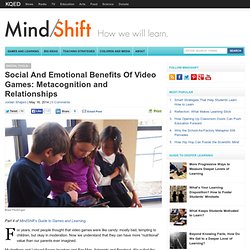
For years, most people thought that video games were like candy: mostly bad, tempting to children, but okay in moderation. Now we understand that they can have more “nutritional” value than our parents ever imagined. Danah boyd - It's Complicated. It's Complicated: The Social Lives of Networked Teens. danah boyd, Yale University Press, 2014.
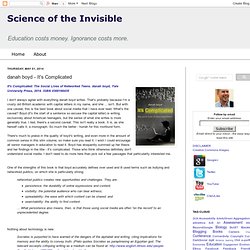
ISBN 0300166435 I don't always agree with everything danah boyd writes. That's probably because I'm a crusty old British academic with capital letters in my name, and she ... isn't. But with one caveat, this is the best book about social media that I have ever read. 8 Ideas, 10 Guides, And 17 Tools For A Better Professional Learning Network. Personal learning networks are a great way for educators to get connected with learning opportunities, access professional development resources, and to build camaraderie with other education professionals.

Although PLNs have been around for years, in recent years social media has made it possible for these networks to grow exponentially. Now, it’s possible to expand and connect your network around the world anytime, anywhere. But how exactly do you go about doing that? Check out our guide to growing your personal learning network with social media, full of more than 30 different tips, ideas, useful resources, and social media tools that can make it all possible. Tips & Ideas. Index of Entrepreneurial Activity. The Rise of Networked Individuals and their role in the life of entrepreneurs. By Lee Rainie Pew Internet Director Lee Rainie gave a keynote address to USASBE‘s annual conference in Hilton Head, S.C.

Older Adults and Technology Use. America’s seniors have historically been late adopters to the world of technology compared to their younger compatriots, but their movement into digital life continues to deepen, according to newly released data from the Pew Research Center.

In this report, we take advantage of a particularly large survey to conduct a unique exploration not only of technology use between Americans ages 65 or older and the rest of the population, but within the senior population as well. Two different groups of older Americans emerge. The first group (which leans toward younger, more highly educated, or more affluent seniors) has relatively substantial technology assets, and also has a positive view toward the benefits of online platforms. #review: Technologically Mediated Embodiment. This is the first post in a new Cyborgology series we call #review.
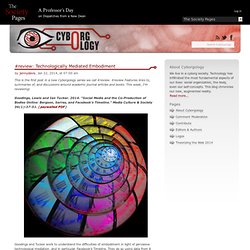
#review Features links to, summaries of, and discussions around academic journal articles and books. This week, I’m reviewing: Goodings, Lewis and Ian Tucker. 2014. Twitter Handbook for Teachers. Twitter Handbook for Teachers. Learning Theories for the Digital Age. Why Learning Through Social Networks Is The Future. By Paul Moss, edmerger.com Students Need Professional Learning Networks, Too Learning to create, manage and promote a professional learning network (PLN) will soon become, if it’s not already, one of the most necessary and sought after skills for a global citizen, and as such, must become a prominent feature of any school curriculum.
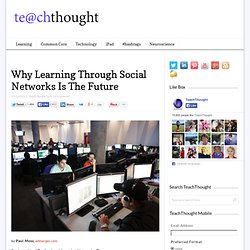
Few progressive educationalists would argue that a personal learning network (PLN) is not incredibly valuable and important. Passionate advocates including Murray, Whitby, and Sheninger lead with clarity in such discussions. The wealth of professional development that stems from such a network is quickly defining it as an essential tool for teachers, and will, I believe, replace organised costly professional development undertaken by organisations. How Online Educators Benefitted by Walking-the-Talk with Collaborative Instructional Design.
This post examines how instructors teaching online can develop pedagogical and instructional skills by collaborating, communicating and building knowledge online with peers using technological tools and applications. A paper published recently in the Journal of Online Teaching and Learning (JOLT) highlights (perhaps unknowingly) one of the most effective methods for teaching faculty and instructors how to become skilled in online pedagogy and instruction—walking-the-talk. In the paper instructors did exactly what the students need to do to learn effectively and deeply online, by collaborating, contributing knowledge, sharing and creating an artifact [in this case two online courses] virtually. What’s significant is that collaboration and learning occurred via technological applications, i.e. Nnected Learning: the next generation of workplace learning practices. 12 Principles for Responding to Negative Online Comments.
Due to convenience, the opportunity to receive a direct response and the potential to kick up a fuss when not treated as they expect, customers are turning to social media for customer service and other product and service-related support rather than dealing with call centres. Despite this, a recent study shows that the top Singaporean telecoms operators together receive an average 1,700 negative customer comments a day via social media. Such volume requires dedicated teams to pick through the debris and assess which complaints should be answered and how.
Singtel’s Facebook page, for instance, is testament to customers’ frustrations with what they see as the company’s poor 3G coverage, high costs and inferior customer service, to the extent that even the most anodyne promotion is belted with a slew of unrelated moans. Yet very few of these complaints are responded to. Singtel and others cannot bury their heads in the digital sand and hope the problem will somehow disappear. Connect: Extension.usu.edu/files/publications/publication/FC_Technology_2013-01pr.pdf. IT as a Core Academic Competence. B.S. Detection for Digital Content. 20 Tips for Creating a Professional Learning Network - Getting Smart by Miriam Clifford. “20 Tips for Creating a Professional Learning Network” by Miriam Clifford first appeared on the InfomED blog. Networking is a prime form of 21st century learning. The world is much smaller thanks to technology. Learning is transforming into a globally collaborative enterprise.
Take for example scientists; professional networks allow the scientific community to share discoveries much faster. Digital Media - New Learners Of The 21st Century. Social Media: The New Knowledge Channel. The Essential Elements of Digital Literacies. Digital literacy.